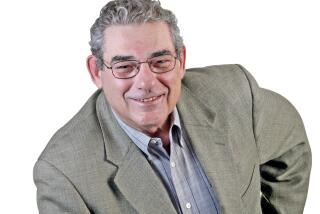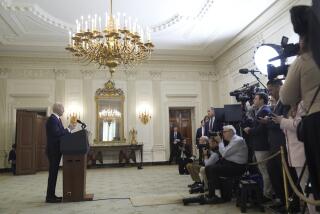L.A. TV ‘news’: Same old song and dance
In the television news business, they call them duopolies. How about a more descriptive name? Zombie stations.
Turn on KCOP-TV Channel 13 for the weeknight news at 11 p.m. and you won’t see KCOP anchors. Or KCOP reporters. They aren’t backed by KCOP writers. In the last year, even the KCOP logo disappeared.
The station’s news operation has been taken over -- lock, stock, news desk and teleprompter -- by its duopoly partner, KTTV-TV Channel 11, the local Fox television affiliate, which itself has been hobbled by mass layoffs in recent months.
The emergence of KCOP as the first (but likely not last) of the news undead may seem like a trivial milepost in what has been a decades-long slide by local TV news into banality, trivia and marginalization.
But it’s worth talking about the new low for a couple of reasons. First, corporate executives promised duopolies could help save, rather than continue to emasculate, local news. Second, a recent survey by the Pew Center for the People & the Press found that 64% of Americans rely on television for most of their local news.
Saying you count on TV to learn what goes on in your city is a little like saying you go to Raiders games for lessons in civility. But I digress.
Local TV has been caught in the same revolutionary change that has done serious damage to newspapers, magazines, record labels and moviemakers. Accustomed to profit margins that peaked in the 1980s at 50% or more, local TV outlets now strain to get half that, with much of their revenue siphoned off by the Internet and, recently, the recession.
Still, 20% profits are not unusual in many local TV operations, said Steve Ridge, president of the media strategy group at television consultant Frank Magid & Associates. Those would be heady margins in almost any other business. But a decade of consolidation, big borrowing and inflated expectations has left television bosses always wanting more.
The only way owners have found to prop up big profits is to pound down expenses. Thus the duopoly, with stations allowed to cooperate under federal antitrust waivers.
A 2001 buyout of a rival firm gave Rupert Murdoch’s News Corp. ownership of KCOP and created its duopoly with KTTV, already part of Murdoch’s Fox television group.
Over the decade, the two stations have progressively merged their operations. KCOP dumped its own anchors in favor of KTTV’s last December. If you watch KCOP’s half hour of news, you will see KTTV anchors Carlos Amezcua and Christine Devine. In the corner of the screen, there’s a KTTV logo.
In other words, an independent KCOP has quietly disappeared from the local news scene, with its single 11 p.m. program merely a repackaged version of KTTV’s news at 10.
“Don’t you think that’s outrageous? Apparently they just don’t care,” said Pete Noyes, a legend among local TV news people for his plain-spoken ways and the multiple award-winning stories he produced over nearly five decades in L.A. news. “They can always find a lower way to go.”
If you had the misfortune to happen on the parade of hoochie-coochie, sex and sizzle that KCOP once fobbed off as news, you might wonder, “Who cares?”
But there was a time when local network affiliates, and even poor stepchildren like KCOP, produced original news from City Hall, the state Capitol and points beyond.
Noyes, who retired from KTTV last year, himself once pummeled the Metropolitan Transportation Authority for the huge cost overruns that taxpayers subsidized with a half-cent sales tax. Among his myriad other investigations: a piece on contamination that spread to the Simi and west San Fernando valleys from Rocketdyne’s Santa Susana Field Laboratory.
Like their cousins in radio and newspapers, including the Los Angeles Times, every local TV news operation has been cut in recent years. KTTV took a sharp blow last month when the station cut about 100 reporters, editors, engineers and others.
General Manager Kevin Hale told me Thursday that “our on-air product is as good as it ever was.” But several staffers, who spoke anonymously for fear of alienating management, said news reach and morale have suffered.
“We are covering fewer stories because we have fewer crews,” said one veteran reporter. “You still have the feeling like you would like to be crusading for the public good, but now it’s just like ‘What can we manage to get done.’ ”
Veteran reporters with a history of digging deeper -- like Chris Blatchford, John Schwada and Phil Shuman -- get thrown into more daily stories and have less time for special projects.
Still, there always seems to be time for playing footsie. Late Tuesday, I treated myself to KCOP, which spent a few minutes reporting on the “hunky Santa” competition at a local mall, with plenty of shots of shirtless young musclemen preening for the camera. Then weatherman Mark Thompson danced -- yes, danced -- across the set as the day’s forecast flitted across the screen.
Apparently improvisational dance is a Fox leitmotif, since the next day I caught Maria Quiban shimmying through part of her forecast on KTTV. In the most cringe-inducing moment, fill-in anchor Michael Brownlee joined in, swaying in his chair and loosening his tie as if he might shift into full Chippendales mode.
Can anything be done to restore more substance to the market that brought the world Warren Olney, Jess Marlow and Tom Brokaw?
In New York and Honolulu, citizen activists filed complaints with the FCC, arguing that duopolies and cooperation agreements between stations have starved audiences of the independent news voices TV stations should provide in exchange for their slice of the public airwaves.
During the Clinton administration, the FCC briefly flirted with requiring minimum levels of news cover- age. But it’s doubtful that the feds, locked in epochal fights over issues such as access to broadband and the Internet, will take up these daunting ownership issues any time soon.
That leaves market forces to drive better news coverage. I can’t help but believe that Los Angeles would flock to a sharp newscast -- focusing on government, culture, the environment and outdoors in one of the most vibrant cities on Earth.
But to test my theory we’d need one news director, just one, to break out of the same old dance.
--
More to Read
The complete guide to home viewing
Get Screen Gab for everything about the TV shows and streaming movies everyone’s talking about.
You may occasionally receive promotional content from the Los Angeles Times.







